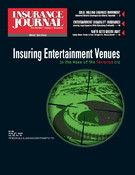Twenty years ago, no one envisioned top entertainers earning $20 million for a single film, or for 90 days of work. Unusual work schedule aside, the dollars involved in protecting these individuals creates a unique underwriting hurdle that traditional individual disability or group long term disability (LTD) markets have been unable to effectively respond to. This being the case, a small group of specialty carriers have focused on these unique risks by developing a series of products to underwrite the enormous exposures, yet maintain reasonable underwriting profitability.
In order for a carrier to accept an entertainment risk, underwriters recognized that the basic disability policy forms and rating classifications that existed in the traditional disability market were an unacceptable foundation for the entertainment world. Movie stars, recording artists and television talent experience dramatic swings in income throughout their career. With this in mind, the instrumental market innovation was the development of a term disability contract.
Underwriters at Lloyd’s of London were the first to design a term disability policy that would last for a defined period, usually one to three years in duration. In contrast to a more traditional disability policy (non-cancelable to 65 years old), a term product allowed underwriters to review the financial risk at the expiration of each term and offer renewal terms consistent with the entertainer’s current compensation. While Lloyd’s remains a dominant player in the direct and reinsurance marketplace for this type of coverage, a few domestic insurance companies offer a unique set of products geared toward this market.
Underwriting PDI for entertainers
Disability strikes without regard to occupation, rank or income. Even entertainers with considerable net worth need to protect their family and lifestyle against an unforeseen illness or injury. The insurance planner must understand the unique concerns of the entertainment client and entertainment underwriting in order to design, underwrite and implement a disability income policy to protect their client’s needs. Entertainment underwriters are highly focused on two key underwriting issues—financial justification and lifestyle.
Unlike other markets, in the entertainment market the insurance planner’s primary relationship is with a business manager. Business managers are usually certified public accountants that generally function as an entertainer’s front office. Business management firms pay bills, often determine suitable investments, and manage insurance programs.
The first step to develop a solid underwriting file is to secure two years tax returns (with all schedules) from the entertainer’s business manager. If there is inconsistency from year to year, it is helpful to have the business manager compose a short letter outlining the current projects and expected earnings over the next 12 months. Detailed financial information allows underwriters to design the most aggressive offer from day one.
As with any disability case, a basic “fact find” with the business manager will reveal key data that will help structure an effective insurance program. Of key importance are age, health history, income history, and net worth. Many entertainers earn a tremendous amount of money on a gross basis.
However, their support system and lifestyle can seriously deteriorate their gross earnings to a modest net income. Insurance producers must probe to learn the net income figure as that is the basis for financial underwriting. Entertainment underwriters will rarely concern themselves with net worth for this class of business and will allow significant unearned income (25 percent or more) before offsetting against potential disability benefits.
The other consideration, lifestyle, refers not only to the client’s standard of living but the way they live as well. Are there factors in the client’s life that may affect the risk—hazardous hobbies, penchant for partying, etc.? To some extent, the entertainer’s public image plays a part in how conservative or aggressive the underwriter may be in offering benefits.
Key person disability
Key person protection covering disability and death are essential components of an overall risk management plan for all business, including those in the entertainment industry. Recording companies, book publishers, and production companies have common risk management challenges. Their “product” tends to be tied to specific individuals who are not easily replaced. If a lead actor dies or becomes disabled, production stops. The book publisher who advances their best selling author millions of dollars can’t recover the advance if the author is disabled and cannot produce the contracted work.
Coverage in this niche takes on many forms, and the unique nature of the risks varies significantly from client to client. Creative insurance programs, which can be underwritten on a manuscript form, are available from top underwriters who specialize in this market. Like any other insurance sale, understanding your client’s needs and wants, coupled with a call to an underwriter who specializes in the entertainment business is critical to success. Creative solutions are often more important than cost.
If you are looking for an exciting niche in the insurance world, see what Hollywood has in store for you. With the right contacts and relationships, entertainment insurance offers a unique opportunity to add revenue to your practice while working in one of the most dynamic market segments our industry has to offer.
Edward A. Tafaro is responsible for developing and managing senior client relationships as well as overseeing BISYS – Special Markets’ overall marketing efforts. In addition to these activities, he manages the financial, administrative and underwriting functions. Prior to joining BISYS, he was an investment broker in the securities industry.
Topics Profit Loss Underwriting
Was this article valuable?
Here are more articles you may enjoy.


 Class Action Settlements Flooded With Fraudulent Claims by Scammers
Class Action Settlements Flooded With Fraudulent Claims by Scammers  Allstate Tops Profit Estimates on Higher Premiums, Investment Returns
Allstate Tops Profit Estimates on Higher Premiums, Investment Returns  The Future Is Near for Self-Driving Trucks on US Roads
The Future Is Near for Self-Driving Trucks on US Roads  Travelers to Open Technology Office in Atlanta
Travelers to Open Technology Office in Atlanta 


